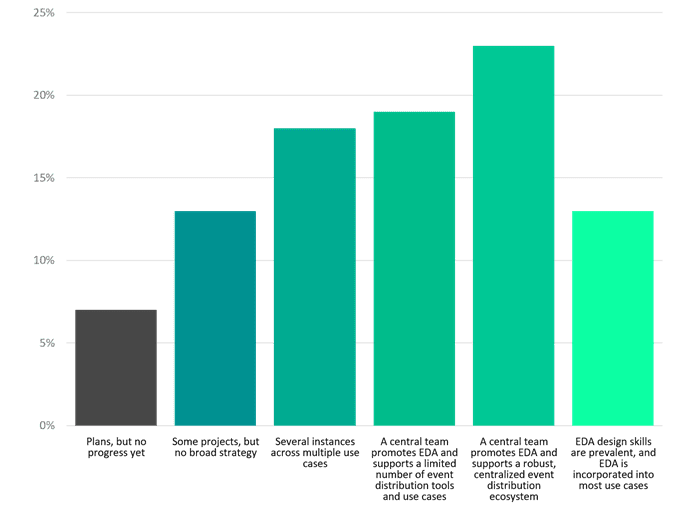This summer Solace contracted independent research firm Coleman Parkes to survey over 800 IT professionals around the world about their familiarity with event-driven architecture, their understanding of its advantages and costs, and how far along the road to full event-driven implementation their organization is.
I found the results (which are summarized here) fascinating, particularly the responses to the question “Which of the following statements best reflects the implementation of EDA across your organization?” A couple of years ago I shared my perspective on that topic in light of a Gartner report called The 5 Steps Toward Pervasive Event-Driven Architecture.
The Gartner report, which was refreshed in 2020, aimed to help enterprises assess their readiness for a digital future that will be increasingly event driven. They proposed a “maturity model” to help businesses rate themselves along a spectrum that ranged from “Incidental” where they used event-driven architecture sparingly, if at all, to “Pervasive” where they apply the principles of event-driven architecture across their enterprise.
The recent survey results aren’t an exact match to the Gartner maturity model, of course, but the idea is similar. I was pleased to see that most respondents believe their organization is far along. As you can see below most folks said their organization at least has in place a central team that promotes event-driven architecture and supports some tools and use cases. Many more reporting that their organization has implemented a robust ecosystem of tools, or even that the required skills are prevalent and event-driven architecture is part of most use cases.
What the Data Means to Me: The EDA Beachhead
While only 13% have achieved the highest level of adoption which maps to “Pervasive” in Gartner’s model, I take away from this the fact that most companies achieved enough buy-in from enough stakeholders to establish an event-driven architecture beachhead.
Establishing such a beachhead means they have overcome the first big hurdle and are on their way to benefiting from event-driven architecture. From there organizations must put in place the platforms, processes, and best practices it takes to get events flowing across their organization, and then figure out how to govern and manage event streams and event-driven applications with the same level of rigor they apply to their non-event-driven cousins. But once the door is open and people start seeing event-driven architecture success in one area, the idea tends to pick up steam.
Event-Driven Architecture isn’t Just for “Real-Time” Industries Anymore
Over my 20+ years in this space, well before event streaming and event brokers were even terms, I’ve seen the principles of event-driven architecture drive the digitization of investment banking, help scale telco’s from 2G to 5G, and drive manufacturing to where it is today. These industries demanded a different way to think about applications, and now we’re seeing this play out in every other major industries around the world. We live in a hyper-connected, always-on society, and every user or application across supply chain, payments, government, CPG, etc. want to sense, act, and move faster. Event-driven architecture is the capability that can make this happen
This survey quantifies what we’ve seen over the last five years or so, as we’ve been helping IT leaders and practitioners in an increasing variety of new verticals like CPG, aviation, and retail understand the technical fundamentals and business benefits of event-driven architecture. Because of the increasing ubiquity of cloud services, mobile devices, 5G, and the Internet of Things, every business needs to operate in real-time and decouple their digital assets for greater agility.
Nobody has more experience helping companies transform their business through event-driven architecture than our Chief Technology Solutions Officer Sumeet Puri, who has published a white paper called “The Architect’s Guide to Implementing EDA.” It’s proven to be one of our most popular assets because it lays out a proven six-step process that he’s seen many enterprises use to get started on the road to event-driven architecture. Here’s a summary of the steps:
- Develop the Event-Driven Architecture Mindset
- Identify Candidates for Real-Time
- Build Eventing Foundation
- Pick a Pilot Application
- Decompose it into Asynchronous, Event-Driven Microservices
- With that Win Under Your Belt, Rinse and Repeat

Conclusion
At Solace we’re passionate about enabling event-driven architecture because we believe the adoption of it will result in better run businesses, better customer experiences, and faster innovation. It’s encouraging to see the adoption of event-driven architecture ramping up so quickly, and I’m proud that we have the experience and solutions to help companies reap the rewards.
Explore other posts from categories: Business | For Architects

 Denis King
Denis King


